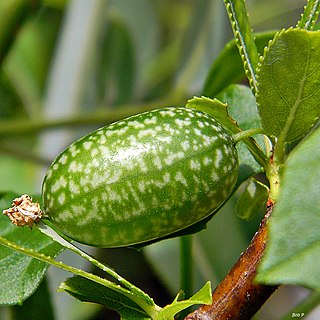
Célestin Alfred Cogniaux was a Belgian botanist. Amongst other plants, the genus Neocogniauxia of orchids is named after him.

Trillium vaseyi is a species of flowering plant in the family Melanthiaceae. It is a spring-flowering perennial plant found only in the southeastern United States. The specific epithet vaseyi honors the American plant collector George Richard Vasey, not to be confused with his father George S. Vasey. The species is commonly called Vasey's Trillium. It is also known as the sweet wakerobin, sweet trillium, or sweet beth.

Rugelia nudicaulis, the sole species of the genus Rugelia, blooms in summer. It is a wildflower endemic to higher elevations in the Great Smoky Mountains. It is a rare species in Tennessee. Genetic diversity in this plant, assessed using allozymes, is so low that the species may not survive changing environmental conditions. Both the scientific name and the common names honor Ferdinand Rugel, a botanist and plant collector who collected plant specimens throughout the southeastern United States during the period 1840–1848.

George S. Vasey was an English-born American physician and botanist. He practiced medicine in Illinois for nearly two decades. He was appointed Chief Botanist at the United States Department of Agriculture in 1872, a position he held for the remainder of his life. His greatest achievement was the building up of the United States National Herbarium.
Eryngium vaseyi is a species of flowering plant in the family Apiaceae. It is endemic to California. The specific epithet vaseyi honors the American plant collector George Richard Vasey who made extensive collections in the region in 1880 and 1881. The species is commonly called Vasey's coyote-thistle.

Vaseyochloa is a monotypic genus in the grass family Poaceae. Its sole species, the flowering plant Vaseyochloa multinervosa, is endemic to Texas. It is commonly known as Texasgrass.

Salvia vaseyi, the scallop-leaf sage, bristle sage or wand sage, is a perennial native to the western Colorado Desert. The specific epithet vaseyi honors the American plant collector George Richard Vasey, not to be confused with his father George S. Vasey.

Euphronia is a genus of three species of shrubs native to northern South America and is the only genus in the family Euphroniaceae. It was previously classified in the Vochysiaceae family and elsewhere due to its unique floral features, but the APG III system of 2009 recognized Euphroniaceae as distinct and placed Euphronia in it. Based on molecular data from the rbcL gene, it is sister to the Chrysobalanaceae.

Rhododendron vaseyi, the pinkshell azalea, is a species of flowering plant in the heath family Ericaceae. It is endemic to the Appalachian highlands of North Carolina. The specific epithet vaseyi honors the American plant collector George Richard Vasey and his father Dr. George Vasey, Chief Botanist at the United States Department of Agriculture from 1872 to 1893. The species is sometimes referred to as the Vasey Rhododendron.

Chrysothamnus vaseyi is a species of flowering plant in tribe Astereae in the daisy family Asteraceae. It is native to the Southwestern United States. The specific epithet vaseyi honors the American botanist George S. Vasey. The species is commonly called Vasey's rabbitbrush.
Hymenoxys vaseyi is a species of flowering plant in the daisy family Asteraceae. It is native to the Southwestern United States. The specific epithet vaseyi honors the American plant collector George Richard Vasey who made extensive collections in the region in 1880 and 1881. The species is commonly called Vasey's rubberweed.

Quercus vaseyana is a species of tree in the beech family Fagaceae. It is native to northern Mexico and the U.S. state of Texas. The specific epithet vaseyana honors the American botanist George S. Vasey. The species is commonly called the Vasey oak.

Melothria is a genus of flowering plants in the family Cucurbitaceae, native to the Americas from the United States to Argentina, and with some introductions in Africa and elsewhere. A number of Old World species formerly in Melothria were reassigned to Cucumis.

Primula frenchii, French's shootingstar, is a species of flowering plant in the family Primulaceae. It is native to the central and southern United States, in southern Illinois, Indiana, Kentucky, Arkansas, and Alabama. It grows in moist, shady areas such as ledges near streams and under sandstone cliffs.

Echinopepon is a genus of flowering plants in the family Cucurbitaceae, native to the southwestern United States, Mexico, Central America, and South America. Tendrillate vines, their prickly fruits are operculate, with the prickles themselves being stipitate glandular.
Ampelosicyos is a genus of flowering plants belonging to the family Cucurbitaceae.
Hanburia is a genus of plants in the tribe Sicyoeae of the gourd family, Cucurbitaceae. Its native range is from Mexico to Venezuela and Peru. It is found in the countries of Colombia, Costa Rica, Ecuador, Guatemala, Honduras, Mexico, Panamá, Peru and Venezuela.
Ferdinand Ignatius Xavier Rugel was a German-born American pharmacist, botanist, and plant collector.
George Richard Vasey (1853–1921) was an American plant collector who collected in at least eight U.S. states including California, North Carolina, and Washington. He was the son of Dr. George S. Vasey, a physician and botanist. The botanical activities of father and son overlapped in time, so the two men are often confused.
Juncus vaseyi is a species of flowering plant in the rush family Juncaceae. It is native to North America. The specific epithet vaseyi honors the American botanist George S. Vasey. The species is commonly called Vasey's rush.













